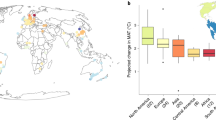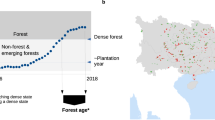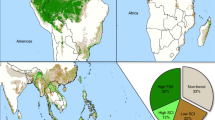Abstract
Forests hold and remove vast quantities of carbon dioxide from the atmosphere. Given the challenges of reducing emissions quickly enough and the stakes involved, planting new trees is therefore crucial in the broader battle against climate change. Accordingly, the proposal from the G20 summit of November 2021, to fight the climate crisis by planting 1 trillion trees by 2030, has been accepted, elevating tree restoration as an emissions-reduction strategy. At the same time, increasing urbanization has rendered more and more forested areas to the periphery of cities. Here we show that, globally, between 141 and 322 Mha are potentially available for tree restoration in such peri-urban areas. New forests around cities could provide crucial ecosystem services, improving air quality, mitigating temperatures, reducing heat islands and removing greenhouse gases as well as other pollution from the atmosphere. We constructed a 500-m-resolution global map of the peri-urban areas suitable for tree restoration. We found that these areas may host between 241 and 106 billion trees, depending on different land-availability scenarios, and between 101 and 34 billion trees when excluding areas that currently serve as croplands. Almost 80% of such trees could be hosted in just 20 countries. Although forest restoration activities such as tree planting cannot replace reducing carbon emissions, incrementing peri-urban forests can play a crucial role in the fight against climate change. Our results and the maps we constructed may help decision-makers to come to more informed decisions about where to focus reforestation efforts.
This is a preview of subscription content, access via your institution
Access options
Subscribe to this journal
Receive 12 digital issues and online access to articles
$119.00 per year
only $9.92 per issue
Buy this article
- Purchase on Springer Link
- Instant access to full article PDF
Prices may be subject to local taxes which are calculated during checkout





Similar content being viewed by others
Data availability
To ensure the full reproducibility and transparency of our research, we provide all of the data used in our analysis at https://code.earthengine.google.com/?accept_repo=users/sfrancini/urban. Raw data are available in the Google Earth Engine catalog at https://developers.google.com/earth-engine/datasets. The GAIA dataset is available at https://developers.google.com/earth-engine/datasets/catalog/Tsinghua_FROM-GLC_GAIA_v10. The PDB is available at https://developers.google.com/earth-engine/datasets/catalog/OpenLandMap_PNV_PNV_BIOME-TYPE_BIOME00K_C_v01. The WorldCover map is available at https://developers.google.com/earth-engine/datasets/catalog/ESA_WorldCover_v100. The JAXA forest mask is available at https://developers.google.com/earth-engine/datasets/catalog/JAXA_ALOS_PALSAR_YEARLY_FNF.
Code availability
The Google Earth Engine codes used to obtain final and intermediate products can be accessed at the Google Earth Engine repository at https://code.earthengine.google.com/?accept_repo=users/sfrancini/urban. To access the repository a Google Earth Engine account is needed. If readers need support in executing the codes or in downloading final and intermediate products please ask for support to saverio.francini@unifi.it
References
Department of Economic and Social Affairs World Population Prospects 2022 (United Nations, 2022); https://population.un.org/wpp/Download/Standard/Population
IPCC Special Report on Global Warming of 1.5 °C (eds Masson-Delmotte, V. et al.) (World Meteorological Organization, 2018); https://www.ipcc.ch/sr15/resources/headline-statements/
Crowther, T. et al. Mapping tree density at a global scale. Nature 525, 201–205 (2015).
Canadell, J. G. & Raupach, M. R. Managing forests for climate change mitigation. Science 320, 1456–1457 (2008).
IPCC Climate Change 2023: Synthesis Report (eds Core Writing Team, Lee, H. & Romero, J.) 35–115 (IPCC, 2023); https://doi.org/10.59327/IPCC/AR6-9789291691647
Bastin, J. F. et al. The global tree restoration potential. Science 365, 76–79 (2019).
Lewis, S. L., Mitchard, E. T. A., Prentice, C., Maslin, M. & Poulter, B. Comment on ‘The global tree restoration potential’. Science 366, eaaz0388 (2019).
New EU Forest Strategy for 2030: Communication from the Commission to the European Parliament, the Council, the European Economic and Social Committee and the Committee of the Regions COM(2021) 572 final (European Commission, 2021).
Gao, J. & O’Neill, B. C. Mapping global urban land for the 21st century with data-driven simulations and Shared Socioeconomic Pathways. Nat. Commun. 11, 2302 (2020).
Revi, A. et al. in Climate Change 2014: Impacts, Adaptation, and Vulnerability (eds Field, C. B. et al.) Ch. 8 (IPCC, Cambridge Univ. Press, 2014).
Department of Economic and Social Affairs World Urbanization Prospects: The 2018 Revision ST/ESA/SER.A/420 (United Nations, 2019).
International Day of Forests 2018. SDG Knowledge Hub https://sdg.iisd.org/events/international-day-of-forests-2018/ (2018).
Dowtin, A. L., Cregg, B. C., Nowak, D. J., & Levia, D. F. Towards optimized runoff reduction by urban tree cover: a review of key physical tree traits, site conditions, and management strategies. Landsc. Urban Plan. https://doi.org/10.1016/j.landurbplan.2023.104849 (2023).
Hu, Y. et al. Alternative scenarios for urban tree surveys: investigating the species, structures, and diversities of street trees using street view imagery. Sci. Total Environ. https://doi.org/10.1016/j.scitotenv.2023.165157 (2023).
Rinkes, E. H. & Keessen, J. Ecosystem services in urban and peri-urban areas: a review of recent developments. Land Use Policy 29, S70–S79 (2012).
Bottalico, F. et al. Air pollution removal by green infrastructures and urban forests in the city of Florence. Agric. Agric. Sci. Procedia https://doi.org/10.1016/j.aaspro.2016.02.099 (2016).
Peng, C., Ren, H., Li, W. & Liu, Y. The impacts of forest restoration on air quality in peri-urban areas: a systematic review. Environ. Sci. Pollut. Res. 24, 20783–20794 (2017).
Li, J., Li, S., Wang, X. & Ma, Y. Forest restoration in peri-urban areas: case studies from the Yangtze River Delta, China. Land Use Policy 73, 404–413 (2018).
Baker, T. & McAlpine, C. A. The role of urban and peri-urban agriculture in conservation and restoration: a review. Environ. Sci. Pollut. Res. 24, 8205–8218 (2017).
Endreny, T. A. Strategically growing the urban forest will improve our world. Nat. Commun. 9, 1160 (2018).
Heat and health. World Health Organization Fact Sheet https://www.who.int/news-room/fact-sheets/detail/climate-change-heat-and-health (2016).
Mentaschi, L. et al. Global long-term mapping of surface temperature shows intensified intra-city urban heat island extremes. Glob. Environ. Change 72, 102441 (2022).
Kats, G. et al. Cooling Cities, Slowing Climate Change and Enhancing Equity: Costs and Benefits of Smart Surfaces Adoption for Baltimore (Smart Surfaces Coalition, 2022); https://static1.squarespace.com/static/5b104d0b365f02ddb7b29576/t/63581b28ddadf1029123e192/1666718506360/Baltimore+Draft+Document10.22.22.pdf
Viana, H. & Pinto, C. Forest restoration in peri-urban areas: challenges and opportunities. Environ. Sci. Pollut. Res. 24, 20765–20771 (2017).
Gorelick, N. et al. Google Earth Engine: planetary-scale geospatial analysis for everyone. Remote Sens. Environ. 202, 18–27 (2017).
Gong, P. et al. Annual maps of global artificial impervious area (GAIA) between 1985 and 2018. Remote Sens. Environ. https://doi.org/10.1016/j.rse.2019.111510 (2020).
Hengl, T. et al. Global mapping of potential natural vegetation: an assessment of machine learning algorithms for estimating land potential. PeerJ 6, e5457 (2018).
JAXA Global 25 m Resolution PALSAR-2/PALSAR Mosaic and Forest/Non-Forest Map (FNF) Dataset Description (Japan Aerospace Exploration Agency, Earth Observation Research Center, 2016).
Tsendbazar, N. et al. Product Validation Report WorldCover_PVR_v1.1 (European Space Agency, 2020); https://worldcover2020.esa.int/data/docs/WorldCover_PVR_V1.1.pdf
JAXA Global 25 m Resolution PALSAR-2 Forest/Non-Forest Map (FNF) (Ver.2.0.0) Dataset Description (Japan Aerospace Exploration Agency, Earth Observation Research Center, 2022); https://www.eorc.jaxa.jp/ALOS/en/dataset/pdf/DatasetDescription_PALSAR2_FNF_v200a.pdf
Shimada, M. et al. New global forest/non-forest maps from ALOS PALSAR data (2007–2010). Remote Sens. Environ. 155, 13–31 (2014).
Gullison, R. E. & Canadell, J. G. Reforestation in the tropics: a review of barriers to implementation and incentives. Environ. Res. Lett. 2, 034002 (2007).
Folberth, C. et al. The global cropland-sparing potential of high-yield farming. Nat. Sustain. 3, 281–289 (2020).
Schindele, S. et al. Implementation of agrophotovoltaics: techno-economic analysis of the price–performance ratio and its policy implications. Appl. Energy https://doi.org/10.1016/j.apenergy.2020.114737 (2020).
Zeng, M. et al. Model-based analysis of the long-term effects of fertilization management on cropland soil acidification. Environ. Sci. Technol. 51, 3843–3851 (2017).
Zanaga, D. et al. ESA WorldCover 10 m 2020 v100. Zenodo https://doi.org/10.5281/zenodo.5571936 (2021).
Arino, O. et al. Global Land Cover Map for 2009 (GlobCover 2009). PANGAEA https://doi.org/10.1594/PANGAEA.787668 (2012).
Estreguil, C., Caudullo, G., De Rigo, D. & San-Miguel-Ayanz, J. Forest Landscape in Europe: Pattern, Fragmentation and Connectivity EUR 25717 (European Union, 2012).
da Silva, L. P. et al. Natural woodlands hold more diverse, abundant, and unique biota than novel anthropogenic forests: a multi-group assessment. Eur. J. For. Res. 138, 461–472 (2019).
Scheidel, A. & Work, C. Forest plantations and climate change discourses: new powers of ‘green’ grabbing in Cambodia. Land Use Policy 77, 9–18 (2018).
Ratnasingam, J. et al. Perceptions by smallholder farmers of forest plantations in Malaysia. Forests 12, 1378 (2021).
Rakotonarivo, O. S. et al. Resolving land tenure security is essential to deliver forest restoration. Commun. Earth Environ. 4, 179 (2023).
Legesse, B. A., Jefferson-Moore, K. & Thomas, T. Impacts of land tenure and property rights on reforestation intervention in Ethiopia. Land Use Policy 70, 494–499 (2018).
Camara, G. et al. Impact of land tenure on deforestation control and forest restoration in Brazilian Amazonia. Environ. Res. Lett. 18, 065005 (2023).
Wolfersberger, J., Amacher, G., Delacote, P. & Dragicevic, A. The dynamics of deforestation and reforestation in a developing economy. Environ. Dev. Econ. 27, 272–293 (2022).
Song, X. P. et al. Global land change from 1982 to 2016. Nature 560, 639–643 (2018).
Reginster, I. & Rounsevell, M. Scenarios of future urban land use in Europe. Environ. Plann. B Plann. Des. 33, 619–636 (2006).
Gottero, E., Larcher, F. & Cassatella, C. Defining and regulating peri-urban areas through a landscape planning approach: the case study of Turin Metropolitan Area (Italy). Land 12, 217 (2023).
Melchiorri, M. & Kemper, T. Establishing an operational and continuous monitoring of global built-up surfaces with the Copernicus Global Human Settlement Layer. In Proc. 2023 Joint Urban Remote Sensing Event (JURSE) (IEEE, 2023); https://doi.org/10.1109/JURSE57346.2023.10144201
Uhl, J. H. & Leyk, S. A scale-sensitive framework for the spatially explicit accuracy assessment of binary built-up surface layers. Remote Sens. Environ. 279, 113117 (2022).
Leyk, S., Uhl, J. H., Balk, D. & Jones, B. Assessing the accuracy of multi-temporal built-up land layers across rural-urban trajectories in the United States. Remote Sens. Environ. 204, 898–917 (2018).
Uhl, J. H. et al. Exposing the urban continuum: implications and cross-comparison from an interdisciplinary perspective. Int. J. Digit. Earth 13, 22–44 (2020).
Roy Chowdhury, P. K., Bhaduri, B. L. & McKee, J. J. Estimating urban areas: new insights from very high-resolution human settlement data. Remote Sens. Appl. 10, 93–103 (2018).
Francini, S. et al. Reusing remote sensing-based validation data: comparing direct and indirect approaches for afforestation monitoring. Remote Sens. 15, 1638 (2023).
Harrison, S. BIOME 6000 DB classified plotfile version 1. University of Reading Dataset https://researchdata.reading.ac.uk/99/ (2017).
Harrison, S. P. & Bartlein, P. in The Future of the World’s Climate 2nd edn (eds Henderson, A. & McGuffie, K.) 403–436 (Elsevier, 2012); https://doi.org/10.1016/B978-0-12-386917-3.00014-2
Acknowledgements
This study was supported by the following projects: PNRR, funded by the Italian Ministry of University and Research, Missione 4 Componente 2, ‘Dalla ricerca all’impresa’, Investimento 1.4, Project CN00000033; MULTIFOR ‘Multi-scale observations to predict Forest response to pollution and climate change’ PRIN 2020 Research Project of National Relevance funded by the Italian Ministry of University and Research (prot. 2020E52THS); SUPERB ‘Systemic solutions for upscaling of urgent ecosystem restoration for forest related biodiversity and ecosystem services’ H2020 project funded by the European Commission, number 101036849 call LC-GD-7-1-2020; EFINET ‘European Forest Information Network’ funded by the European Forest Institute, Network Fund G-01-2021; and FORWARDS: the forestward observatory to secure resilience of european forests (Project 101084481). We thank N. Gorelick, one of the founders of Google Earth Engine, for the continuous support he has given us.
Author information
Authors and Affiliations
Contributions
S.M., S.F., and G. Chirici conceived the idea. S.F., G. Chirici and S.M. designed the methodology. S.F. performed the analysis and wrote the Google Earth Engine codes. S.F. wrote the paper with contributions from G. Chirici, L.C., P.C., G. Caldarelli and S.M.
Corresponding author
Ethics declarations
Competing interests
The authors declare no competing interests.
Peer review
Peer review information
Nature Cities thanks Paloma Carinanos, Cynnamon Dobbs, Sophia Ratcliffe and the other, anonymous, reviewer(s) for their contribution to the peer review of this work.
Additional information
Publisher’s note Springer Nature remains neutral with regard to jurisdictional claims in published maps and institutional affiliations.
Supplementary information
Supplementary Information
Supplementary Figs. 1 and 2.
Supplementary Data 1
Accuracy assessment of predicted areas available for forest restoration activities.
Supplementary Data 2
Comparison between restoration areas committed by countries within the Bonn Challenge and the available peri-urban areas we identified under the three scenarios.
Rights and permissions
Springer Nature or its licensor (e.g. a society or other partner) holds exclusive rights to this article under a publishing agreement with the author(s) or other rightsholder(s); author self-archiving of the accepted manuscript version of this article is solely governed by the terms of such publishing agreement and applicable law.
About this article
Cite this article
Francini, S., Chirici, G., Chiesi, L. et al. Global spatial assessment of potential for new peri-urban forests to combat climate change. Nat Cities 1, 286–294 (2024). https://doi.org/10.1038/s44284-024-00049-1
Received:
Accepted:
Published:
Issue Date:
DOI: https://doi.org/10.1038/s44284-024-00049-1



